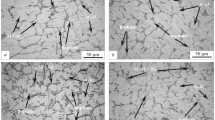Abstract
The influence of modification by ultradispersed materials on the structure and physicomechanical properties of alloys is considered. Nanostructured boron nitride and aluminum hydroxide monohydrate (boehmite) are chosen as modifying additions to study their influence on the structure formation in a zinc–aluminum–copper antifriction alloy. Scanning electron microscopy and electron-probe microanalysis are used to identify high-hardness phases in the alloy structure. Modifying particles are found to affect the hardness of the alloy, which increases significantly with the number of particles. The strength of the alloy depends on both the number and the size of introduced particles, and powders with small grain sizes are more effective to increase the strength of the alloy. Moreover, silicon carbide is shown to exert a stronger effect on the strength of silumins than alumina does.








Similar content being viewed by others
REFERENCES
D. N. Sokolov, “Thermodynamic and structural characteristics of metal nanoparticles in melting and solidification: theory and computer simulation,” Extended Abstract of Cand. Sci. (Phys.-Math.) Dissertation, Tver State University (Tver, 2016).
V. I. Anikina, T. R. Gil’manshina, and V. N. Baranov, Structure and Properties of Aluminum–Magnesium Alloys: Monograph (SFU, Krasnoyarsk, 2012).
T. Galambos and A. Surovek, Structural Stability of Steel: Concepts and Applications for Structural Engineers (Wiley, New Jersey, 2008).
A. V. Antsupov, Jr., A. V. Antsupov, and V. P. Antsupov, Theory and Practice of Providing the Reliability of Machine Parts Using Kinetic Strength and Wear Resistance Criteria: Monograph (Magnitogorsk State Technical University, Magnitogorsk, 2015).
E. A. Lesyuk and V. P. Alekhin, Formation of Nano- and Submicrocrystalline Structures in Tool and Structural Materials and Ensuring Their Thermal Stability: Monograph (Moscow Gom. Industrial University, Moscow, 2009).
A. M. Orishich, A. N. Cherepanov, V. P. Shapeev, and N. B. Pugacheva, Nanomodification of Welded Joints during Laser Welding of Metals and Alloys (Izd. SO RAN, Novosibirsk, 2014).
A. V. Petrunin, A. V. Panfilov, and A. A. Panfilov, “On the effect of modification by refractory nanoparticles on the structure and properties of aluminum-matrix composites,” Litein. Proizv., No. 10, 17–20 (2009).
V. B. Akimenko, Powder Metallurgy in Ferrous Metallurgy of Russia (Metallurgizdat, Moscow, 2014).
O. O. Stolyarova, “Substantiation of the composition and structure of cast antifriction aluminum alloys with low-melting-point metals,” Candidate’s Dissertation in Engineering (Moscow, 2016).
V. V. Moskvichev, G. G. Krushenko, A. E. Burov, et al., Nanopowder Technologies in Mechanical Engineering: Monograph (Izd. Sibirsk. Federal. Univ., Kransoyarsk, 2013).
A. V. Lyasnikova et al., Modified Hydroxiapatites and Nanocomposite Plasma Coatings Based on Them (Saratov. Gos. Tekhn. Univ., Saratov, 2016).
L. E. Agureev, “Development of a method for producing high-strength aluminum composites using modification by nanooxide powder microadditions,” Extended Abstract of Cand. Sci. (Eng.) Dissertation, Moscow Institute of Steel and Alloys (Moscow, 2015).
I. V. Kocheshkov, “Analysis of the formation of physical contact between composite components during the densification of a workpiece consisting of aluminum foil layers and boron fibers,” Proizv. Prokata, No. 12, 15–19 (2013).
A. A. Kur, “Development of techniques for a quantitative estimation of a microstructure for predicting the mechanical properties of industrial hypoeutectic silumins,” Extended Abstract of Cand. Sci. (Eng.) Dissertation (St. Petersburg Polytechn. Univ., St. Petersburg, 2017).
V. M. Vorotyntsev and V. D. Skupov, Basic Technologies of Micro- and Nanoelectronics: Tutorial (Prospekt, Moscow, 2017).
Author information
Authors and Affiliations
Corresponding author
Additional information
Translated by K. Shakhlevich
Rights and permissions
About this article
Cite this article
Sudnik, L.V., Rudnitskii, F.I., Rudnitskii, K.F. et al. Technological Possibilities of Increasing the Quality and Decreasing the Cost of the Products Operating under High Loads at the Stage of Metallurgical Treatment. Russ. Metall. 2018, 1273–1278 (2018). https://doi.org/10.1134/S0036029518130232
Received:
Published:
Issue Date:
DOI: https://doi.org/10.1134/S0036029518130232




